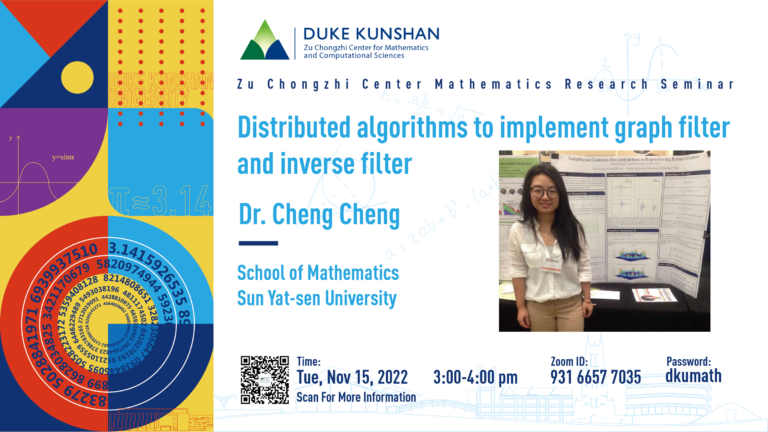Start
End
Location
Type
Share
Event details
Zu Chongzhi Center Mathematics Research Seminar
Date and Time (China standard time): Tuesday, November 15, 3:00-4:00pm
Zoom ID: 931 6657 7035
Passcode: dkumath
Title: Distributed algorithms to implement graph filter and inverse filter
Speaker: Cheng Cheng
Bio: Cheng Cheng is currently a research fellow at Sun Yat-sen University. Before that, she was a postdoc supervised by Professor Ingrid Daubechies at Duke University. Her research interests include applied and computational harmonic analysis, sampling theory, phaseless sampling and reconstruction, and graph signal processing and distributed algorithms. Cheng’s research has been published on Applied and Computational Harmonic Analysis, Journal of Functional Analysis, IEEE Transaction on Signal Processing, Signal Processing, Journal of Fourier Analysis and Applications, IEEE Signal Processing Letters, etc.
Abstract: Graph signal processing provides an innovative framework to process data on graphs. Eigenvectors of matrices on a network have been used for understanding influence of a vertex and spectral clustering. For matrices with small geodesic-width and their given eigenvalues, we propose preconditioned gradient descent algorithms to find eigenvectors. Graph filters and their inverses have been widely used in denoising, smoothing, sampling, interpolating and learning. Implementation of graph filter and its inverse filtering procedure on spatially distributed networks (SDNs) is a remarkable challenge, as each agent on an SDN is equipped with a data processing subsystem with limited capacity and a communication subsystem with confined range due to engineering limitations. In this talk, I will introduce the graph filter and the associated inverse filtering on a spatially distributed network. I will also introduce iterative distributed algorithms which are applicable for the implementation of inverse filtering on SDNs.



